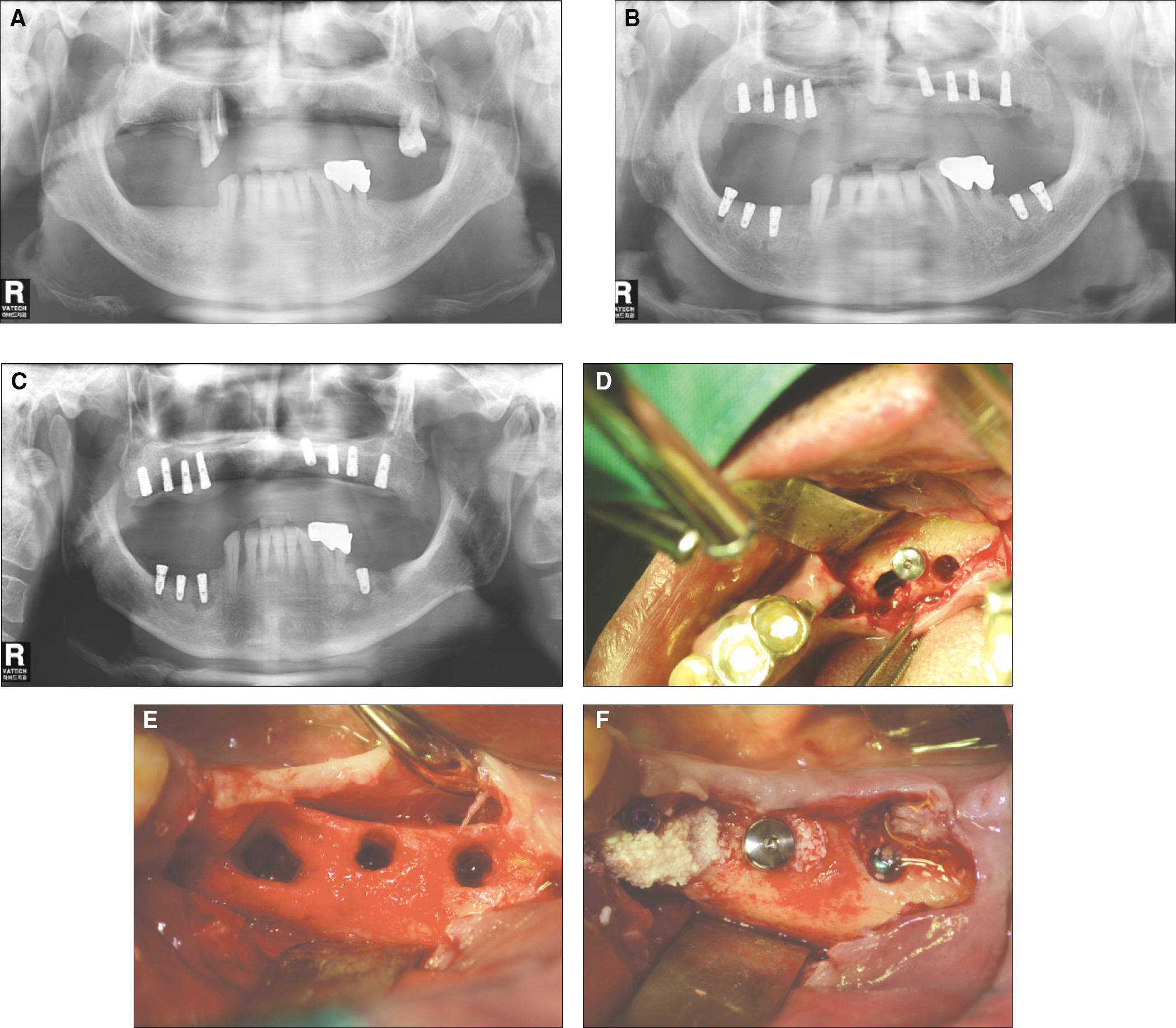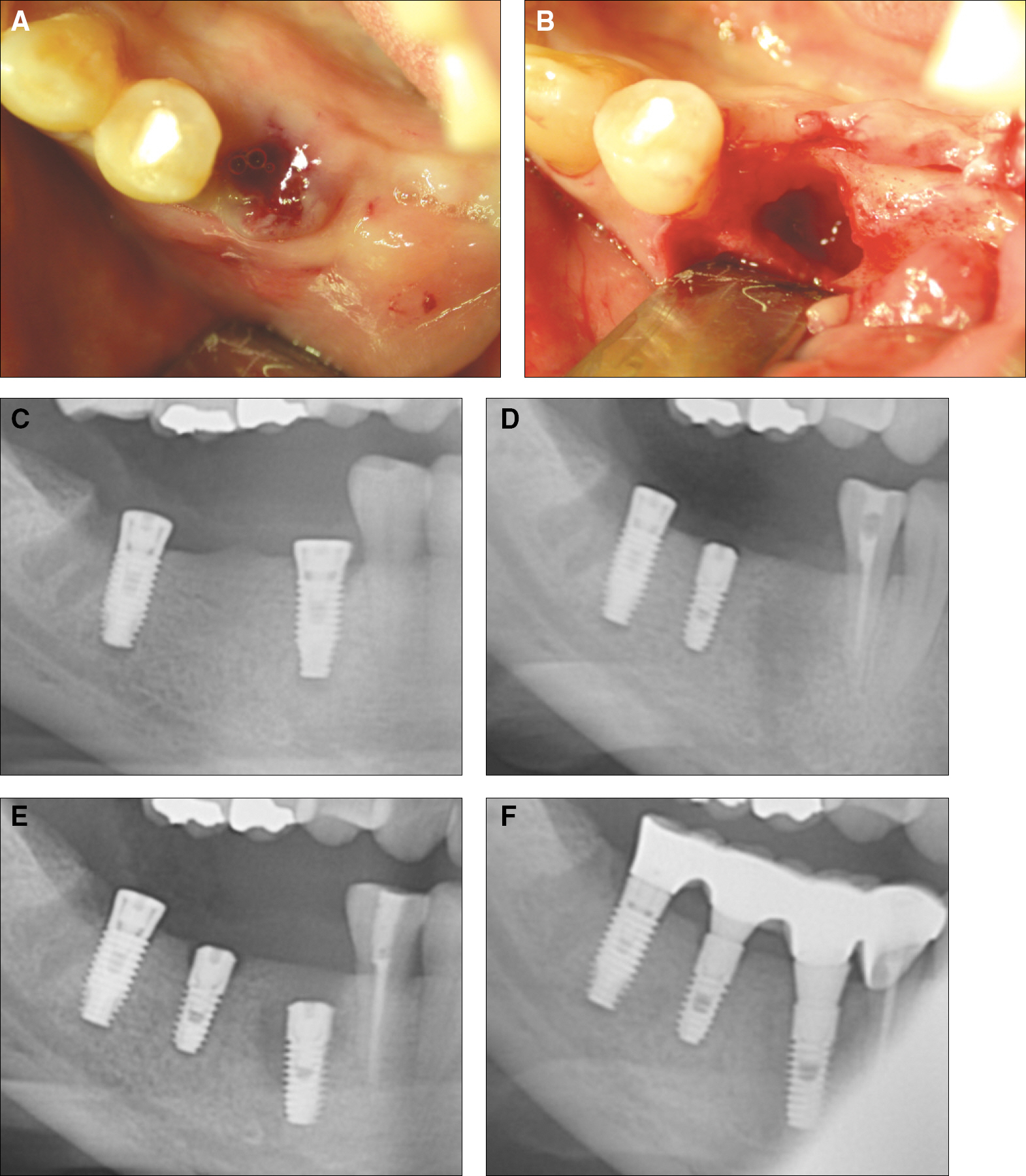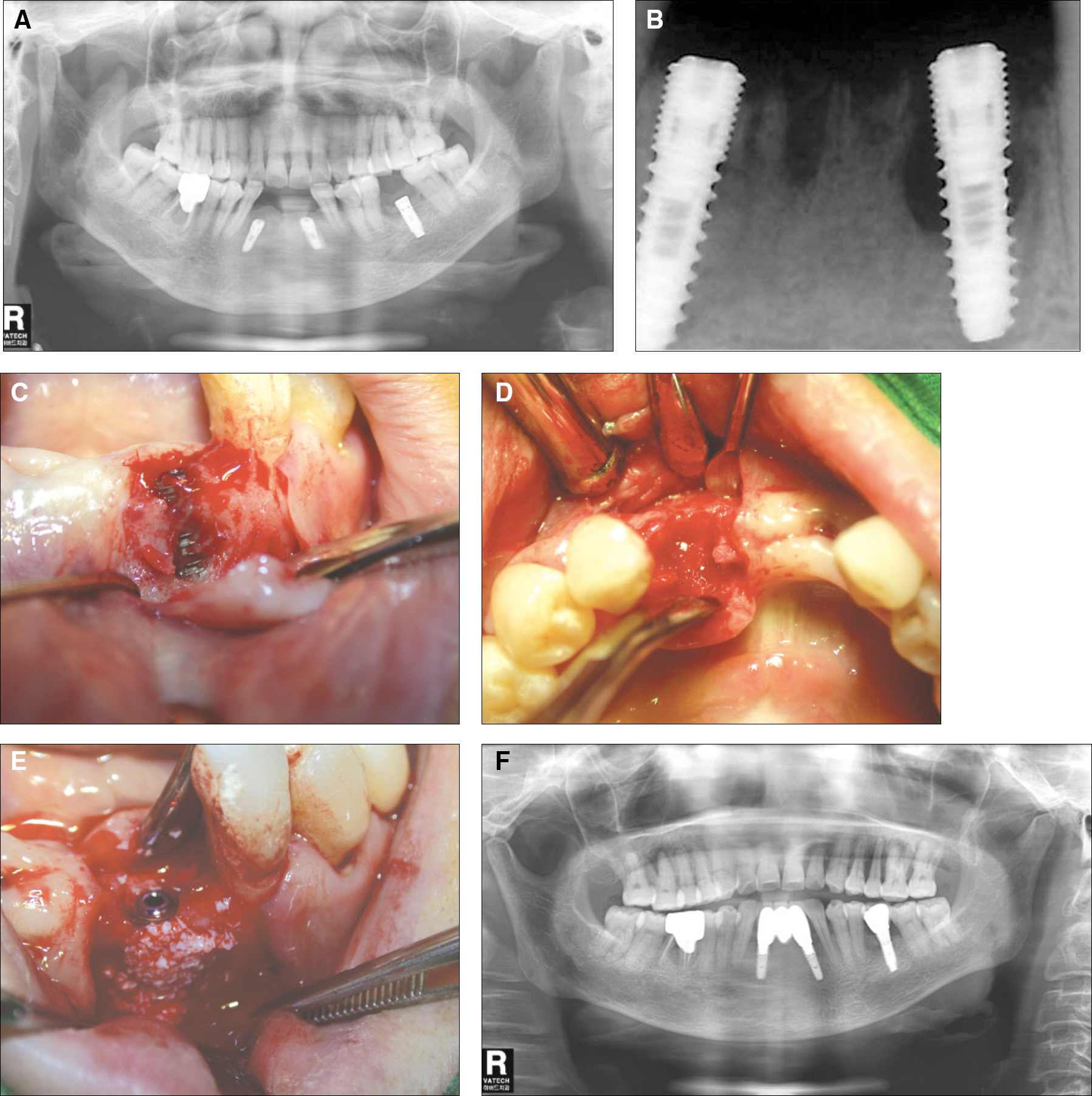J Korean Assoc Oral Maxillofac Surg.
2011 Oct;37(5):406-414.
Thermally induced bone necrosis during implant surgery: 3 case reports
- Affiliations
-
- 1Department of Oral and Maxillofacial Surgery, Sanggye Paik Hospital, College of Medicine, Inje University, Seoul, Korea. Dentpd@paik.ac.kr
- 2Department of Oral and Maxillofacial Surgery, Ilsan Paik Hospital, College of Medicine, Inje University, Goyang, Korea.
- 3S & H Dental Clinic, Seoul, Korea.
Abstract
- Thermally induced bone necrosis during implant surgery is a rare phenomenon and a potential contributing factor to implant failure. The frictional heat generated at the time of surgery causes a certain degree of necrosis of the surrounding differentiated and undifferentiated cells. The bone necrosis occurred in the mandible in all three cases, leading to a soft tissue lesion and pain. In each case, radiolucent areas appeared in the middle and apical portions of the implant 4 weeks after surgery. Thermally induced bone necrosis did not improve following systemic antibiotic medication, necessitating surgical treatment. The nonintegrated implants were removed, and meticulous debridement of dead bone and granulation tissue was performed. Then, new implants were implanted along with the placement of autogenous and xenogenic bone covered with a collagen membrane. No further complications occurred after re-operation. The radiolucencies around the new implants gradually resolved entirely, and the soft tissue lesions healed successfully. At 4-5 months after reoperation, implant loading was initiated and the implant-supported restorations have been functioning. The aim of this case report is to present the successful clinical treatment of three cases suspected to be caused by thermally induced bone necrosis after implant drilling.
Keyword
MeSH Terms
Figure
Reference
-
References
1. Branemark PI, Adell R, Breine U, Hansson BO, Lindstrom J, Ohlsson A. Intraosseous anchorage of dental prostheses. I. Experimental studies. Scand J Plast Reconstr Surg. 1969; 3:81–100.
Article2. Higuchi KW, Folmer T, Kultje C. Implant survival rates in partially edentulous patients: A 3-year prospective multicenter study. J Oral Maxillofac Surg. 1995; 53:264–268.3. Mazzocchi A, Passi L, Moretti R. Retrospective analysis of 736 implants inserted without antibiotic therapy. J Oral Maxillofac Surg. 2007; 65:2321–2323.
Article4. Li W, Chow J, Hui E, Lee PKH, Cjow R. Resprospective study on immediate functional loading of edentulous maxillas and mandibles with 690 implants, up to 71 months of follow-up. J Oral Maxillofac Surg. 2009; 67:2653–2662.5. Buser D, Schenk RK, Steinemann S, Fiorellini JP, Fox CH, Stich H. Influence of surface characteristics on bone integration of titanium implants. A histomorphometric study in miniature pigs. J Biomed Mater Res. 1991; 25:889–902.
Article6. Pye AD, Lockhart DEA, Dawson MP, Murray CA, Smith AJ. A review of dental implants and infection. J of Hospital Infection. 2009; 72:104–110.7. Bashutski JD, D'Silva NJ, Wang HL. Implant compression necrosis: Current understanding and case report. J Periodontol. 2009; 80:700–704.
Article8. Quirynen M, De Soete M, Van Steenberghe D. Infectious risks for oral implants: A review of the literature. Clin Oral Implants Res. 2002; 13:1–19.
Article9. Branemark PI, Zarb GA, Albrektsson T. Tissue integrated prostheses: Osseointegration in clinical dentistry. Chicago, IL: Quintessence;1985. p. 129–143.10. Eriksson R, Albrektsson T. Temperature thresholds for heat induced bone tissue injury: A vital-microscopic study in the rabbit. J Prosthet Dent. 1983; 50:101–107.11. Eriksson R, Albrektsson T. The effect of heat on bone regeneration: An experimental study in the rabbit using the bone growth chamber. J Oral Maxillofac Surg. 1984; 42:705–711.
Article12. Sharawy M, Misch CE, Weller N, Tehemer S. Heat generation during implant drilling: The significance of motor speed. J Oral Maxillofac Surg. 2002; 60:1160–1169.
Article13. Chacon GE, Bower DL, Larsen PR, McGlumphy EA, Beck FM. Heat production by 3 implant drill systems after repeated drilling and sterilization. J Oral Maxillofac Surg. 2006; 64:265–269.
Article14. Eriksson R, Adell R. Temperatures during for the placement of implants using the osseointegration technique. J Oral Maxillofac Surg. 1986; 44:4–7.15. Cordioli G, Majzoub Z. Heat generation during implant site preparation: An in vitro study. Int J Oral Maxillofac Implants. 1997; 12:186–193.16. Ercoli C, Funkenbusch PD, Lee HJ, Moss ME, Graser GN. The influence of drill wear on cutting efficiency and heat production during osteotomy preparation for dental implants: A study of drill durability. Int J Oral Maxillofac Implants. 2004; 19:335–349.17. Queiroz TP, Souza FA, Okamoto R, Margonar R, Pereira-Filho VA, Garcia Junior IR, et al. Evaluation of immediate bone-cell viability and of drill wear after implant osteotomies: Immunohistochemistry and scanning electron microscopy analysis. J Oral Maxillofac Surg. 2008; 66:1233–1240.
Article18. Yoshida K, Uoshima K, Oda K, Maeda T. Influence of heat stress to matrix on bone formation. Clin. Oral Impl. Res. 2009; 20:782–790.19. Cem Sener B, Dergin G, Gursoy B, Kelesoglu E, Slih I. Effects of irrigation temperature on heat control in vitro at different drilling depths. Clin. Oral Impl. Res. 2009; 20:294–298.20. Misir AF, Sumer M, Yenisey M, Ergioglu E. Effect of surgical drill guide on heat generated from implant drilling. J Oral Maxillofac Surg. 2009; 67:2663–2668.
Article21. Piattelli A, Piattelli M, Mangano C, Scarano A. A histologic evaluation of eight cases of failed dental implants: Is bone overheating the most probable cause? Biomaterials. 1998; 19:683–690.
Article22. Piattelli A, Scarano A, Balleri P, Favero GA. Clinical and histologic evaluation of an active “Implant Periapical Lesion”: A case report. Int J Oral Maxiilofac Implants. 1998; 13:713–716.23. Penarrocha-Diage M, Boronat-Lopez A, Garcia-Mira B. Inflammatory implant periapical lesion: Etiology, diagnosis, and treatment – presentation of 7 cases. J Oral Maxillofac Surg. 2009; 67:168–173.24. Sverzut AT, Vitti Stabile GA, Moraes M, Mazzonetto R, Fernandes Moreira RW. The influence of tobacco on early dental implant failure. J Oral Maxillofac Surg. 2008; 66:1004–1009.
Article25. Piattelli A, Scarano A, Piattelli M. Abscess formation around the apex of a maxillary root form implant: Cinical and microscopical aspects. A case report. J Periodontol. 1995; 66:899–903.26. Alsaadi G, Quirynen M, Komarek A, van Steenberghe D. Impact of local and systemic factors on the incidence of oral implant failures, up to abutment connection. J Clin Periodontol. 2007; 34:610–617.
Article27. Pommer B, Frantal S, Willer J, Posch M, Watzek G, Tepper G.Impact of dental implant length on early failure rates: a metaanalysis of observational studies. J Clin Periodontol. 2011; 38:856–863.
Article28. Park JC, Ha SR, Kim SM, Kim MJ, Lee JB, Lee JH. A randomized clinical 1-year trial comparing two types of non-submerged dental implants. Clin Oral Implants Res. 2010; 21:228–236.
Article29. Matthews LS, Hirsch C. Temperature measured in human cortical bone when drilling. J Bone joint Surg[Am]. 1972; 54:297–308.30. Rhinelander F, Nelson CL, Steward RD, Steward CL. Experimental reaming of the proximal femur and acrylic cement implantation. Vascular and histologic effects. Clin Orthop. 1979; 141:74–89.31. Turkyilmaz I, Sennerby L, McGlumphy EA, Tozum TF. Biomechanical aspects of primary implant stability: A human cadaver study. Clin Implant Dent Relat Res. 2009; 11:113–119.
Article32. Tehemar SH. Factors affecting heat generation during implant site preparation: A review of biologic observations and future considerations. Int J Oral Maxillofac Implants. 1999; 14:127–136.33. Lundskog J. Heat and bone tissue. An experimental investigation of the thermal properties of bone and threshold levels for thermal injury. Scand J Plast Reconstr Surg. 1972; 9:1–80.34. Lavelle C, Wedgwood D. Effect of internal irrigation on frictional heat generated from bone drilling. J Oral Surg. 1980; 38:499–503.35. Sutter F, Krekeler G, Schwammberger AE, Sutter FJ. Atraumatic surgical technique and implant bed preparation. Quintessence Int. 1992; 23:811–816.
- Full Text Links
- Actions
-
Cited
- CITED
-
- Close
- Share
- Similar articles
-
- One-staged sinus bone graft using tapered porous surfaced implant in lower residual bone height of maxillary sinus
- Implant Surgery with Both Sinus Bone Graft in the Maxillary edentulous patient: A Case Report
- Clinical application of a new systematic implant planning concept (A Clinical Report)
- Management of a dental implant displaced into the mandibular bone marrow space: Case reports
- Iliac Crest Skin Necrosis: A Case Report




